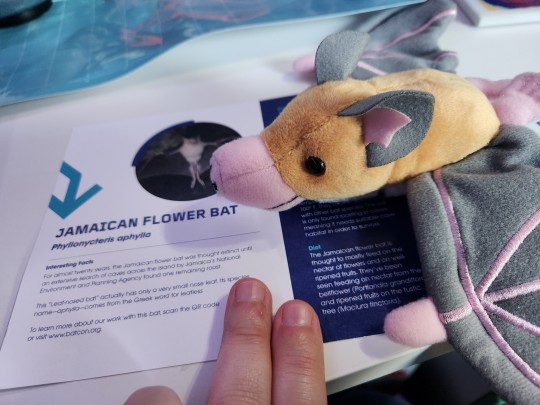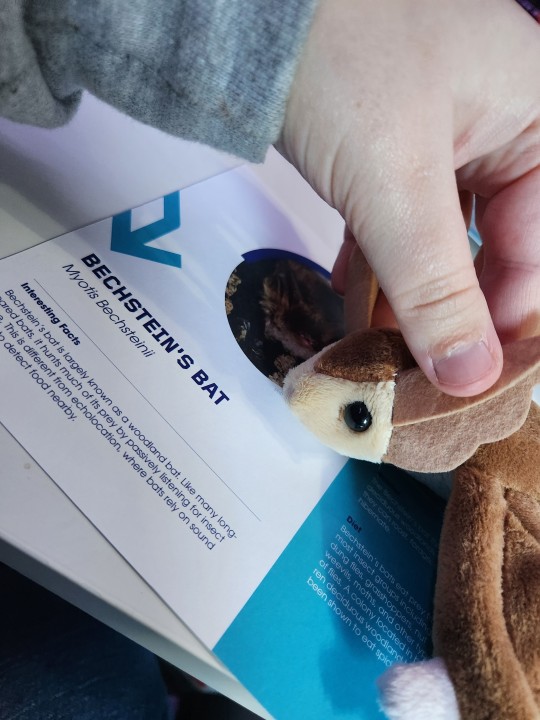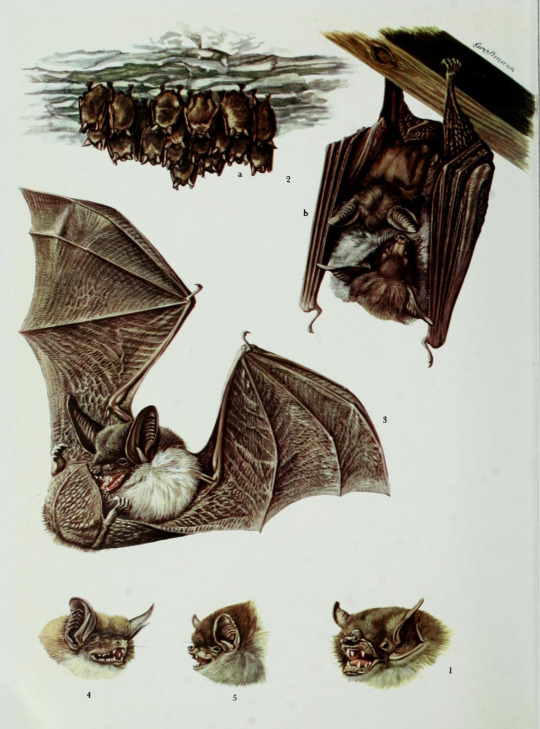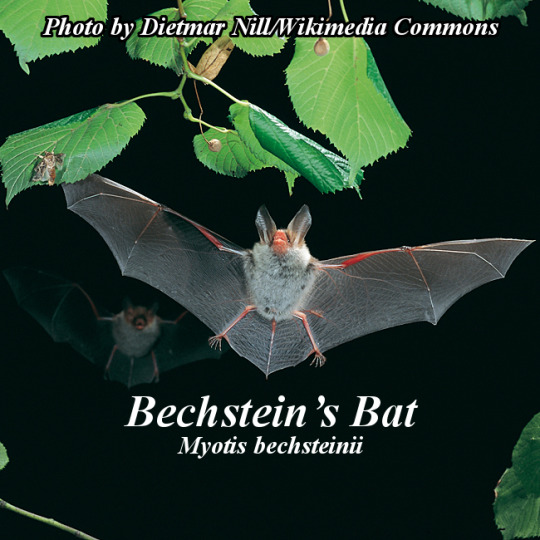#myotis bechsteinii
Explore tagged Tumblr posts
Text



My bat adopts arrived from BCI. I got (in order from left to right):
Nimba Myotis (orange and black)
Jamaican Flower Bat (light brown with big muzzle)
Bechstein's bat (brown)
In hindsight I may have bought myself a duplicate Bechstein's bat. No big though, they are social animals in real life after all.
#bat plushie#myotis bechsteinii#Bechstein's bat#jamaican flower bat#phyllonycteris aphylla#nimba myotis#myotis nimbaensis
42 notes
·
View notes
Text

Grzimek's Animal Life Encyclopedia, vol. 11, Mammals II. 1972.
1.) Mexican funnel-eared bat (Natalus stramineus)
2.) Greater mouse-eared bat (Myotis myotis)
3.) Bechstein's bat (Myotis bechsteinii)
4.) Natterer's bat (Myotis nattereri)
5.) Daubenton's bat (Myotis daubentonii)
#bats#mexican funnel-eared bat#greater mouse-eared bat#bechstein's bat#natterer's bat#daubenton's bat
172 notes
·
View notes
Photo

🦇Bat Fact! Do you know of Bechstein’s Bat (Myotis bechsteinii)? Also known as the “Elusive Carnivore Bat,” this medium-sized vesper bat can be found throughout Europe and Asia and almost exclusively in woodlands. This bat has an average weight of 7-13g and can love up to 21 years. Once in great numbers, this species population has greatly declined; it is hypothesized that the decline is due to the loss of deciduous woodlands. Fossil records actually suggest that this bat was once the most common bat species in Britain! This bat will commonly hunt moths, but also mosquitoes, small flies and beetles. When not hunting, this bat roosts in tree holes and occasionally bat boxes. This bat is listed as “Least Threatened” by the IUCN and is considered “Native and Rare”🦇
📸Photo by Dietmar Nill/Wikimedia Commons📸
#batfacts #bats #bat #akhyls #education
⬇️Follow Bat Facts⬇️ https://akhylsthebat.tumblr.com/ https://www.minds.com/akhylsthebat/ https://twitter.com/AkhylsBatFacts https://t.me/AkhylsBatFacts ❗️Disclaimer: All images used here are for educational purposes and are not used in any way for profit or to promote any products or services. Copyright Disclaimer under section 107 of the Copyright Act 1976, allowance is made for “fair use” for purposes such as criticism, comment, news reporting, teaching, scholarship, education and research. Fair use is a use permitted by copyright statute that might otherwise be infringing❗️
3 notes
·
View notes
Text
A call to wings
This week sees the launch of an updated bat synopsis from Conservation Evidence, adding new studies that have come out since the first synopsis was published in 2013.
The synopsis collects and summarises studies that test conservation actions such as ‘provide bat boxes for roosting bats’, and organises the studies by the action that they test. This focus on solutions makes it a handy point of…
View On WordPress
#agri-environment schemes#agroforestry#Barbastella barbastellus#bats#chauve-souris#conservation evidence#Cynopterus brachyotis#development#evidence#fledermaus#flying foxes#gantries#green bridges#megabats#Megachiroptera#microbats#Microchiroptera#mitigation#murcielago#Myotis bechsteinii#Myotis dasycneme#pipistrella#Plecotus auritus#restoration#underpasses#United Kingdom#wildlife crossings#wire and ball
0 notes
Text
#InternationalBatNight #InternationalBatWeekend #Batfest 28th August - 31st September. Second Day: Alcathoe bat (Myotis alcathoe)/ General Bat Poems/Artwork/Photos. First drafts always welcome. Please join Anjum Wasim Dar, Sarah Westcott and myself in celebrating bats. A slightly longer than a month celebration of Bats kicks of with #InternationalBatNight. I will feature your bat poems, artwork photography, and setting myself the challenge of writing a bat sonnet a day. Anybody written bat poems they would love me to feature on my blog? Please include an up to date, short, third person bio with your contribution. Here are the first eleven day themes: 28th Bats And Coronavirus/General Bat Poems/Artwork/Photos, 29th Alcathoe bat (Myotis alcathoe)/ General Bat Poems/Artwork/Photos, 30th. Mexican Free-tailed Bat (fastest mammal)/ General Bat Poems/Artwork/Photos, 31. Barbastelle bat (Barbastella barbastellus)/ General Bat Poems/Artwork/Photos,1. Giant Golden-crowned Flying Fox (The Largest)/ General Bat Poems/Artwork/Photos, 2. Bechstein’s bat (Myotis bechsteinii)/ General Bat Poems/Artwork/Photos,3. Honduran White Bat (The Tent Maker)/ General Bat Poems/Artwork/Photos, 4. Brandt’s bat (Myotis brandtii)/ General Bat Poems/Artwork/Photos, 5. Ghost Bat (False Vampire)/ General Bat Poems/Artwork/Photos 6. Brown long-eared bat (Plecotus auritus)/ General Bat Poems/Artwork/Photos, 7. Common pipistrelle bat (Pipistrellus pipistrellus)/ General Bat Poems/Artwork/Photos
#InternationalBatNight #InternationalBatWeekend #Batfest 28th August – 31st September. Second Day: Alcathoe bat (Myotis alcathoe)/ General Bat Poems/Artwork/Photos. First drafts always welcome. Please join Anjum Wasim Dar, Sarah Westcott and myself in celebrating bats. A slightly longer than a month celebration of Bats kicks of with #InternationalBatNight. I will feature your bat poems, artwork photography, and setting myself the challenge of writing a bat sonnet a day. Anybody written bat poems they would love me to feature on my blog? Please include an up to date, short, third person bio with your contribution. Here are the first eleven day themes: 28th Bats And Coronavirus/General Bat Poems/Artwork/Photos, 29th Alcathoe bat (Myotis alcathoe)/ General Bat Poems/Artwork/Photos, 30th. Mexican Free-tailed Bat (fastest mammal)/ General Bat Poems/Artwork/Photos, 31. Barbastelle bat (Barbastella barbastellus)/ General Bat Poems/Artwork/Photos,1. Giant Golden-crowned Flying Fox (The Largest)/ General Bat Poems/Artwork/Photos, 2. Bechstein’s bat (Myotis bechsteinii)/ General Bat Poems/Artwork/Photos,3. Honduran White Bat (The Tent Maker)/ General Bat Poems/Artwork/Photos, 4. Brandt’s bat (Myotis brandtii)/ General Bat Poems/Artwork/Photos, 5. Ghost Bat (False Vampire)/ General Bat Poems/Artwork/Photos 6. Brown long-eared bat (Plecotus auritus)/ General Bat Poems/Artwork/Photos, 7. Common pipistrelle bat (Pipistrellus pipistrellus)/ General Bat Poems/Artwork/Photos
Second Day: Alcathoe bat (Myotis alcathoe)/ General Bat Poems/Artwork/Photos Batfact: There are eighteen species of bat in Britain and all are protected under the Wildlife and Countryside Act. One of these species, the Greater mouse-eared bat was officially declared extinct in Britain in 1990, but there were reports of sightings across 29 locations in the UK in the winter of 2011/2012. Bats…

View On WordPress
0 notes
Photo


Oh I looove the cute bat stamp and the wonderful flower stamp from Ukraine! They kindly also gave the Latin names. Bechstein’s bat (Myotis bechsteinii) and Valerian (Valeriana officinalis). The Disney stamp is interesting - I can’t imagine something like that would be issued here.
UA-1767471
#stamp#ukraine#ukrainianstamp#flowerstamp#valerianofficinalis#animalstamp#bat#myotisbechsteinii#postcrossing#snailmail
0 notes
Photo



24) Nocek Bechsteina, Bechstein's bat (Myotis bechsteinii) – gatunek ssaka z rzędu nietoperzy z licznie reprezentowanej w Polsce w gatunki rodziny mroczkowatych. W Polsce jego zasięg ogranicza się do południowej części kraju, najdalej na północ sięga do Cedyńskiego Parku Krajobrazowego, Wielkopolski, okolic Tomaszowa Mazowieckiego i Polesia Lubelskiego. Izolowane stanowisko zimowe znajduje się w Strzalinach na Pomorzu. Jest uważany za gatunek rzadki, choć w południowo-wschodniej części kraju (np. na Lubelszczyźnie, w Puszczy Kozienickiej) jest regularnie spotykanym, niekiedy wręcz częstym gatunkiem nietoperza w dużych kompleksach leśnych. W Polsce jest objęty ścisłą ochroną gatunkową oraz wymagający ochrony czynnej, dodatkowo obowiązuje zakaz fotografowania, filmowania lub obserwacji, mogących powodować płoszenie lub niepokojenie. Umieszczony w Polskiej czerwonej księdze zwierząt, jako gatunek bliski zagrożenia (kategoria NT – near threatened).
0 notes
Text
Nueva noticia publicada en LaFlecha
New Post has been published on https://laflecha.net/el-adn-de-los-murcielagos-podria-ser-el-secreto-de-una-vida-larga-y-saludable/
El ADN de los murciélagos podría ser el secreto de una vida larga y saludable

Científicos demuestran que los genes reparadores del ADN de los murciélagos podrían ser la clave para entender el proceso de envejecimiento.
Con una esperanza de vida media de setenta y ocho años que está aumentando, los europeos pueden esperar vidas más largas. Sin embargo, puede que estas vidas no sean necesariamente saludables, ya que la aparición de las enfermedades relacionadas con la edad ha impedido seguir esta tendencia al alza.
Para comprender mejor el proceso de envejecimiento, un equipo internacional de investigadores llevó a cabo un estudio de diferentes especies de murciélagos. Los resultados fueron publicados recientemente en la revista «Science Advances».
El estudio, que se benefició de una beca de investigación de la UE para el proyecto AGELESS, analizó los telómeros de cuatro especies diferentes de murciélagos salvajes para determinar la función, si la hubiera, que desempeñan en la longevidad de los murciélagos. Entre los mamíferos, los murciélagos son la especie más longeva en relación con el tamaño de su cuerpo. De hecho, de las diecinueve especies de mamíferos que viven más tiempo que los humanos cuando se tiene en cuenta el tamaño corporal, dieciocho son murciélagos.
Empleando datos obtenidos durante más de sesenta años de estudios de campo, el equipo del proyecto intentó averiguar si los telómeros se acortan con la edad en las especies de murciélagos «Rhinolophus ferrumequinum», «Miniopterus schreibersii», «Myotis bechsteinii» y «Myotis myotis».
Los telómeros son los extremos que hay al final de cada hebra de ADN y que protegen nuestros cromosomas. A medida que envejecemos, los telómeros se vuelven cada vez más cortos hasta que ya no pueden hacer su trabajo, lo cual hace que nuestras células comiencen a descomponerse. Una vez que este proceso se activa, nuestros tejidos comienzan a degenerarse y mueren.
Los murciélagos fueron capturados en diferentes lugares de Europa. Se tomaron muestras de tres milímetros de las alas de cada murciélago antes de ponerlos en libertad. Las muestras se congelaron en nitrógeno líquido o se secaron con perlas de sílice. Los resultados de los análisis de telómeros mostraron que, al igual que en la mayoría de los mamíferos, los telómeros se acortan con la edad en las especies de murciélagos «R. ferrumequinum» y «M. schreibersii». Sin embargo, no se encontró ninguna relación entre la longitud del telómero y la edad en el género «Myotis», que incluye la especie de murciélago más longeva estudiada hasta la fecha.
Algunas células pueden combatir el acortamiento de telómeros expresando telomerasa, una enzima que extiende los telómeros de los cromosomas. Para descubrir cómo se puede mantener la longitud de los telómeros en el género «Myotis», los científicos investigaron la expresión de la telomerasa en «M. myotis», cuya esperanza de vida máxima (treinta y siete años) era mucho más larga que la de las otras tres especies estudiadas. Curiosamente, las pruebas no mostraron signos de expresión de telomerasa en este murciélago.
Genes reparadores del ADN
Posteriormente, se realizaron pruebas adicionales para comparar el genoma de las especies del género «Myotis» con los de otros cincuenta y dos mamíferos. Los análisis de 225 genes asociados con el mantenimiento de los telómeros identificaron veintiún genes que pueden desempeñar una función en la prevención del acortamiento de telómeros en murciélagos del género «Myotis». En particular, el gen ATM y el gen SETX, que son responsables de reparar y prevenir el daño del ADN, pueden ser los causantes de la notable longevidad de la especie.
Si estos genes son el motivo por el que los telómeros no se acortan en el género «Myotis», podrían tener un excelente potencial terapéutico, ya que los murciélagos rara vez tienen cáncer. El mantenimiento de la longitud del telómero sin implicación de la telomerasa es especialmente importante para los seres humanos, ya que la expresión de la telomerasa se encuentra en aproximadamente el 90 % de los cánceres humanos.
El proyecto AGELESS (Comparative genomics / ‘wildlife’ transcriptomics uncovers the mechanisms of halted ageing in mammals) ha ayudado a profundizar en la comprensión de los mecanismos que han desarrollado los murciélagos para darles una esperanza de vida larga. Asimismo, ha acercado un paso más a los científicos al descubrimiento de cómo detener el envejecimiento y paliar las enfermedades relacionadas con la edad en los seres humanos.
Para más información, consulte: Proyecto AGELESS
Fuente: CORDIS
0 notes
Note
My family and friends have gotten a bit tired of me sharing all of my bat facts so Umm... here are my favourites:
1. Bats are responsible for spreading the seeds of over 300 fruit species! Without them, we wouldnt have bananas, avocados or chocolate.
2. Bats can reach speeds of over 100mph!!
3. The longest living bat is 41 years old.
4. Baby bats are called pups, which is adorable.
5. Bat in French is chauve souris, meaning bald mouse.
6. Without bats, we would lose over 80 plants are used for medicine. They are also being studied by scientists to develop aids for blind people, and have helped with research and development of vaccines.
My favorite bat is a Bechstein's bat.

image description: a brown bat with white underbelly on a mossy stump
Oh, I love hearing about bats, share with me!
Further Reading:
Bats as Pollinators | Bat Conservation Trust: LINK
The evolution of bat pollination: a phylogenetic perspective | PMC (paper, may be a challenging read, does have pictures): LINK
Speedy bat smashes Speed Record | Bat Conservation International: LINK
The Oldest Bat | Bat Conservation International: LINK
Baby Bat: 5 Pictures and 5 Facts | AZ Animals (did you know that baby bats are also called bittens!): LINK
Baby bats | Smithsonian Tropical Research Institute: LINK
Bats in France (34 of the 41 species found in Europe can be found in France!, this page has them listed in French and English!): LINK
Bats Shrug Off Viruses and Rarely Get Cancer. We’re Trying to Learn From Them. | University of Nebraska Medical Center: LINK
95 notes
·
View notes
Text
#InternationalBatNight #InternationalBatWeekend #Batfest 28th August - 31st September. First day: Bats And Coronavirus/ General Bat Poems. Please join Maggs Vibo, Mike Stone and myself in celebrating bats. A slightly longer than a month celebration of Bats kicks of with #InternationalBatNight. I will feature your bat poems, artwork photography, and setting myself the challenge of writing a bat sonnet a day. Anybody written bat poems they would love me to feature on my blog? Please include an up to date, short, third person bio with your contribution. Here are the first eleven day themes: 28th Bats And Coronavirus/General Bat Poems, 29th Alcathoe bat (Myotis alcathoe), 30th. Mexican Free-tailed Bat (fastest mammal), 31. Barbastelle bat (Barbastella barbastellus),1. Giant Golden-crowned Flying Fox (The Largest), 2. Bechstein’s bat (Myotis bechsteinii),3. Honduran White Bat (The Tent Maker), 4. Brandt’s bat (Myotis brandtii), 5. Ghost Bat (False Vampire), 6. Brown long-eared bat (Plecotus auritus), 7. Common pipistrelle bat (Pipistrellus pipistrellus)
#InternationalBatNight #InternationalBatWeekend #Batfest 28th August – 31st September. First day: Bats And Coronavirus/ General Bat Poems. Please join Maggs Vibo, Mike Stone and myself in celebrating bats. A slightly longer than a month celebration of Bats kicks of with #InternationalBatNight. I will feature your bat poems, artwork photography, and setting myself the challenge of writing a bat sonnet a day. Anybody written bat poems they would love me to feature on my blog? Please include an up to date, short, third person bio with your contribution. Here are the first eleven day themes: 28th Bats And Coronavirus/General Bat Poems, 29th Alcathoe bat (Myotis alcathoe), 30th. Mexican Free-tailed Bat (fastest mammal), 31. Barbastelle bat (Barbastella barbastellus),1. Giant Golden-crowned Flying Fox (The Largest), 2. Bechstein’s bat (Myotis bechsteinii),3. Honduran White Bat (The Tent Maker), 4. Brandt’s bat (Myotis brandtii), 5. Ghost Bat (False Vampire), 6. Brown long-eared bat (Plecotus auritus), 7. Common pipistrelle bat (Pipistrellus pipistrellus)
Day One: Bats And Coronavirus/General Bat Poems -Maggs Vibo (She says of this: Here is my bat poem which is currently at the ‘Quarantine Creations’ art show with The Perkinson Center for the Arts and Education in Virginia: https://www.perkinsoncenter.org/current-show Read “Scapegoating in the Silver Age” by Margaret Viboolsittiseri in the anthology The Mouth of a Lion: Apocalyptic Visual…

View On WordPress
0 notes
Text
#InternationalBatNight #InternationalBatWeekend #Batfest 28th August - 31st September. A slightly longer than a month celebration of Bats kicks of with #InternationalBatNight. I will feature your bat poems, artwork photography, and setting myself the challenge of writing a bat sonnet a day. Anybody written bat poems they would love me to feature on my blog? Please include an up to date, short, third person bio with your contribution. Here are the first eighteen day themes:
#InternationalBatNight #InternationalBatWeekend #Batfest 28th August – 31st September. A slightly longer than a month celebration of Bats kicks of with #InternationalBatNight. I will feature your bat poems, artwork photography, and setting myself the challenge of writing a bat sonnet a day. Anybody written bat poems they would love me to feature on my blog? Please include an up to date, short, third person bio with your contribution. Here are the first eighteen day themes:
-Anjum Wasim Dar 28th Bats And Coronavirus 29th Alcathoe bat (Myotis alcathoe) 30th. Mexican Free-tailed Bat (fastest mammal) 31. Barbastelle bat (Barbastella barbastellus) 1. Giant Golden-crowned Flying Fox (The Largest) 2. Bechstein’s bat (Myotis bechsteinii) 3. Honduran White Bat (The Tent Maker) 4. Brandt’s bat (Myotis brandtii) 5. Ghost Bat (False Vampire) 6. Brown long-eared bat…

View On WordPress
0 notes